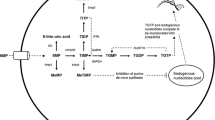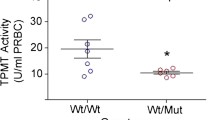Abstract
Objective
Thiopurine drugs are commonly used in pediatric patients for the treatment of acute leukemia, organ transplantation and inflammatory diseases. They are catabolized by the cytosolic thiopurine methyltransferase (TPMT), which is subject to a genetic polymorphism. In children, enzyme activities are immature at birth and developmental patterns vary widely from one enzyme to another. The present study was undertaken to evaluate erythrocyte TPMT activity and the correlation between genotype and phenotype in different age groups from birth to adolescence and adulthood.
Methods
The study included 304 healthy adult blood donors, 147 children and 18 neonates (cord bloods). TPMT activity was measured by liquid chromatography, and genotype was determined using a polymerase chain reaction reverse dot-blot analysis identifying the predominant TPMT mutant alleles (TPMT*3A, TPMT*3B, TPMT*3C, TPMT*2).
Results
There was no significant difference in TPMT activity between cord bloods (n=18) and children (n=147) (17.48±4.04 versus 18.62±4.14 respectively, P=0.424). However, TPMT was significantly lower in children than in adults (19.34±4.09) (P=0.033). In the whole population, there were 91.9% homozygous wild type, 7.9% heterozygous mutants and 0.2% homozygous mutants. The frequency of mutant alleles was 3.0% for TPMT*3A, 0.7% for TPMT*2 and 0.4% for TPMT*3C.
Conclusion
No impact of child development on TPMT activity could be evidenced, suggesting that TPMT activity is already mature at birth. The difference between children and adults was low with reduced clinical impact expected. When individual TPMT activity was compared with genotype, there was an overlapping region where subjects (4.5%, 12 adults, 9 children) were either homozygous wild type or heterozygous, with a TPMT activity below the antimode value. This result highlighted the importance of measuring TPMT activity to detect all patients at risk of thiopurine toxicity.


Similar content being viewed by others
References
Remy CN (1963) Metabolism of thiopyrimidines and thiopurines: S-methylation with S-adenosylmethionine transmethylase and catabolism in mammalian tissue. J Biol Chem 238:1078–1084
Woodson LC, Weinshilboum RM (1983) Human kidney thiopurine methyltransferase: purification and biochemical properties. Biochem Pharmacol 32:819–826
McLeod HL, Krynetski EY, Wilimas JA, Evans WE (1995) Higher activity of polymorphic thiopurine-S-methyltransferase in erythrocytes from neonates compared to adults. Pharmacogenetics 5:281–286
Weinshilboum RM, Raymond FA, Pazmino PA (1978) Human erythrocyte thiopurine methyltransferase: radiochemical microassay and biochemical properties. Clin Chim Acta 85:323–333
McLeod HL, Lin JS, Scott EP, Pui CH, Evans WE (1994) Thiopurine methyltransferase activity in American white subjects and black subjects. Clin Pharmacol Ther 55:15–20
Jacqz-Aigrain E, Bessa E, Medard Y, Mircheva Y, Vilmer E (1994) Thiopurine methyltransferase activity in a French population: HPLC assay conditions and effects of drugs and inhibitors. Br J Clin Pharmacol 38:1–8
Weinshilboum RM, Sladek SL (1980) Mercaptopurine pharmacogenetics: monogenic inheritance of erythrocyte thiopurine methyltransferase activity. Am J Hum Genet 32:651–662
Szumlanski C, Otterness D, Her C, Lee D, Brandriff B, Kelsell D et al (1996) Thiopurine methyltransferase pharmacogenetics: human gene cloning and characterization of a common polymorphism. DNA Cell Biol 15:17–30
Krynetski EY, Fessing MY, Yates CR, Sun D, Schuetz JD, Evans WE (1997) Promoter and intronic sequences of the human thiopurine-S-methyltransferase (TPMT) gene isolated from a human PACI genomic library. Pharm Res 14:1672–1678
Hamdan-Khalil R, Allorge D, Lo-Guidice JM, Cauffiez C, Chevalier D, Spire C et al (2003) In vitro characterization of four novel non-functional variants of the thiopurine S-methyltransferase. Biochem Biophys Res Commun 309:1005–1010
Otterness D, Szumlanski C, Lennard L, Klemetsdal B, Aarbakke J, Park-Hah JO et al (1997) Human thiopurine methyltransferase pharmacogenetics: gene sequence polymorphisms. Clin Pharmacol Ther 62:60–73
Yates CR, Krynetski EY, Loennechen T, Fessing MY, Tai HL, Pui CH et al (1997) Molecular diagnosis of thiopurine S-methyltransferase deficiency: genetic basis for azathioprine and mercaptopurine intolerance. Ann Intern Med 126:608–614
Krynetski EY, Schuetz JD, Galpin AJ, Pui CH, Relling MV, Evans WE (1995) A single point mutation leading to loss of catalytic activity in human thiopurine S-methyltransferase. Proc Natl Acad Sci U S A 92:949–953
Tai HL, Krynetski EY, Yates CR, Loennechen T, Fessing MY, Krynetskaia NF et al (1996) Thiopurine-S-methyltransferase deficiency: two nucleotide transitions define the most prevalent mutant allele associated with loss of catalytic activity in Caucasians. Am J Hum Genet 58:694–702
McLeod HL, Krynetski EY, Relling MV, Evans WE (2000) Genetic polymorphism of thiopurine methyltransferase and its clinical relevance for childhood acute lymphoblastic leukemia. Leukemia 14:567–572
Tai HL, Krynetski EY, Schuetz EG, Yanishevsky Y, Evans WE (1997) Enhanced proteolysis of thiopurine-S-methyltransferase (TPMT) encoded by mutant alleles in humans (TPMT*3A, TPMT*2): mechanisms for the genetic polymorphism of TPMT activity. Proc Natl Acad Sci U S A 94:6444–6449
Wang L, Sullivan W, Toft D, Weinshilboum R (2003) Thiopurine S-methyltransferase pharmacogenetics: chaperone protein association and allozyme degradation. Pharmacogenetics 13:555–564
Lennard L, Lilleyman JS, Van Loon J, Weinshilboum RM (1990) Genetic variation in response to 6-mercaptopurine for childhood acute lymphoblastic leukaemia. Lancet 336:225–229
Colombel JF, Ferrari N, Debuysere H, Marteau P, Gendre JP, Bonaz B et al (2000) Genotypic analysis of thiopurine-S-methyltransferase in patients with Crohn’s disease and severe myelosuppression during azathioprine therapy. Gastroenterology 118:1025–1030
Lennard L, Rees CA, Lilleyman JS, Maddocks JL (1983) Childhood leukemia: a relationship between intracellular 6-mercaptopurine metabolism and neutropenia. Br J Clin Pharmacol 16:359–363
Evans WE, Hon YY, Bomgaars L, Coutre S, Holdsworth M, Janco R et al (2001) Preponderance of thiopurine S-methyltransferase deficiency and heterozygosity among patients intolerant to mercaptopurine or azathioprine. J Clin Oncol 19:2293–2301
Bo Thomsen J, Schroder H, Kristinsson J, Madsen B, Szumlanski C, Weinshilboum RM et al (1999) Possible carcinogenic effect of 6-mercaptopurine on bone marrow stem cells. Cancer 86:1080–1086
Relling MV, Rubnitz JE, Rivera GK, Boyett JM, Hancock ML, Felix CA et al (1999) High incidence of secondary brain tumours after radiotherapy and antimetabolites. Lancet 354:34–39
Kearns GL (1995) Pharmacogenetics and development: are infants and children at increased risk for adverse outcomes? Curr Opin Pediatr 7:220–233
Ganiere-Monteil C, Pineau A, Kergueris MF, Azoulay C, Bourin M (1999) Thiopurine methyl transferase activity: new extraction conditions for high performance liquid chromatographic assay. J Chromatogr B 727:235–239
Cazeneuve C, Pons G, Rey E, Treluyer JM, Cresteil T, Thiroux G et al (1994) Biotransformation of caffeine in human liver microsomes from foetuses, neonates, infants and adults. Br J Clin Pharmacol 37:405–412
Pariente-Khayat A, Pons G, Rey E, Richard MO, D’Athis P, Moran C et al (1991) Caffeine acetylator phenotyping during maturation in infants. Pediatr Res 29:492–495
Hadasova E, Brysova V, Kadlcakova E (1990) N-Acetylation in healthy and diseased children. Eur J Clin Pharmacol 39:43–47
Jacqz-Aigrain E, Cresteil T (1992) Cytochrome P450-dependent metabolism of dextromethorphan: fetal and adult studies. Dev Pharmacol Ther 18:161–168
Leeder JS, Kearns GL (1997) Pharmacogenetics in pediatrics. Implications for practice. Ped Clin North Am 44:55–77
Dervieux T, Medard Y, Verpillat P, Guigonis V, Duval M, Lescoeur B, Suciu S, Vilmer E, Jacqz-Aigrain E (2001) Possible implication of thiopurine S-methyltransferase in occurrence of infectious episodes during maintenance therapy for childhood lymphoblastic leukemia with mercaptopurine. Leukemia 15:1706–1712
Paerregaard A, Schmiegelow (2002) Monitoring azathioprine metabolite levels and thiopurine methyltransferase (TPMT) activity in children with inflammatory bowel disease. Scand J Gastroenterol 37:371–372
Smith L, Morris M, Wrong W (1997) Renal transplantation in children: the Auckland experience 1980–1996. N Z Med J 110:202–204
Corominas H, Domenech M, Laiz M, Gich I, Geli C, Diaz C et al (2003) Is thiopurine methyltransferase genetic polymorphism a major factor for withdrawal of azathioprine in rheumatoid arthritis patients? Rheumatology 42:40–45
Murphy LA, Atherton D (2002) A retrospective evaluation of azathioprine in severe childhood atopic eczema, using thiopurine methyltransferase levels to exclude patients at high risk of myelosuppression. Br J Dermatol 147:308–315
Ferroni MA, Marchi G, Sansone E, Romeo P, Giulianotti PC, Pietrabissa A et al (1996) Variability in the rate of 6-mercaptopurine methylation in the erythrocytes, liver and kidney in an Italian population. Eur J Clin Pharmacol 51:23–29
Coulthard SA, Rabello C, Robson J, Howell C, Minto L, Middleton PG et al (2000) A comparison of molecular and enzyme-based assays for the detection of thiopurine methyltransferase mutations. Br J Haematol 110:599–604
Pacifici GM, Romiti P, Giliani L, Rane A (1991) Thiopurine methyltransferase in humans: development and tissue distribution. Dev Pharmacol Ther 17:16–23
Keizer-Garritsen JJ, Brouwer C, Lamboy LH, Ter Riet P, Bokkerink JP, Trijbels FJ, De Abreu RA (2003) Measurement of thiopurine S-methyltransferase activity in human blood samples based on high-performance liquid chromatography: reference values in erythrocytes from children. Ann Clin Biochem 40:86–93
Lennard L, Singleton HJ (1994) High-performance liquid chromatographic assay of red blood cell thiopurine methyltransferase activity. J Chromatogr B 661:25–33
Petterson B, Almer S, Albertioni F, Söderhäll S, Peterson C (2002) Differences between children and adults in thiopurine methyltransferase activity and metabolite formation during thiopurine therapy: possible role of concomitant methotrexate. Ther Drug Monit 24:351–358
Alves S, Amorim A, Ferreira F, Prata MJ (2001) Influence of the variable number of tandem repeats located in the promoter region of the thiopurine methyltransferase gene on enzymatic activity. Clin Pharmacol Ther 70:165–174
Ameyaw MM, Collie-Duguid ES, Powrie RH, Ofori-Adjei D, McLeod HL (1999) Thiopurine methyltransferase alleles in British and Ghanaian populations. Hum Mol Genet 8:367–370
Spire-Vayron de la Moureyre C, Debuysere H, Fazio F, Sergent E, Bernard C, Sabbagh N et al (1999) Characterization of a variable number tandem repeat region in the thiopurine S-methyltransferase gene promoter. Pharmacogenetics 9:189–198
Marinaki AM, Arenas M, Khan ZH, Lewis CM, Shobowale-Bakre el-M, Escuredo E et al (2003) Genetic determinants of the thiopurine methyltransferase intermediate activity phenotype in British Asians and Caucasians. Pharmacogenetics 13:97–105
Schaeffeler E, Stanulla M, Greil J, Schrappe M, Eichelbaum M, Zanger UM et al (2003) A novel TPMT missense mutation associated with TPMT deficiency in a 5-year-old boy with ALL. Leukemia 17:1422–1424
Hon YY, Fessing MY, Pui CH, Relling MV, Krynetski EY, Evans WE (1999) Polymorphism of the thiopurine S-methyltransferase gene in African-Americans. Hum Mol Genet 8:371–376
Kröplin T, Weyer N, Gutsche S, Iven H (1998) Thiopurine S-methyltransferase activity in human erythrocytes: a new HPLC method using 6-thioguanine as substrate. Eur J Clin Pharmacol 54:265–271
Kröplin T, Iven H (2000) Methylation of 6-mercaptopurine and 6-thioguanine by thiopurine S-methyltransferase. Eur J Clin Pharmacol 56:343–345
Lennard L, Chew TS, Lilleyman JS (2001) Human thiopurine methyltransferase activity varies with red blood cell age. Br J Clin Pharmacol 52:539–546
Cheung ST, Allan RN (2003) Mistaken identity: misclassification of TPMT phenotype following blood transfusion. Eur J Gastroenterol Hepatol 15:1245–1247
Schwab M, Schaeffeler E, Marx C, Zanger U, Aulitzky W, Eichelbaum M (2001) Shortcoming in the diagnosis of TPMT deficiency in a patient with Crohn’s disease using phenotyping only. Gastroenterology 121:500–506
Lowry PW, Franklin CL, Weaver AL, Szumlanski CL, Mays DC, Loftus EV et al (2001) Leucopenia resulting from a drug interaction between azathioprine or 6-mercaptopurine and mesalamine, sulphasalazine, or balsazide. Gut 49:656–664
Acknowledgements
We thank A. Benoussaidh, N. Ripoll and V. De Burgat for their technical assistance.
Author information
Authors and Affiliations
Corresponding author
Rights and permissions
About this article
Cite this article
Ganiere-Monteil, C., Medard, Y., Lejus, C. et al. Phenotype and genotype for thiopurine methyltransferase activity in the French Caucasian population: impact of age. Eur J Clin Pharmacol 60, 89–96 (2004). https://doi.org/10.1007/s00228-004-0732-5
Received:
Accepted:
Published:
Issue Date:
DOI: https://doi.org/10.1007/s00228-004-0732-5




